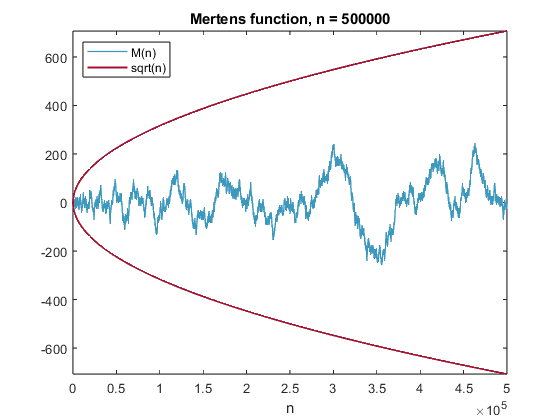| Labfans是一个针对大学生、工程师和科研工作者的技术社区。 | 论坛首页 | 联系我们(Contact Us) |
 |
| Labfans是一个针对大学生、工程师和科研工作者的技术社区。 | 论坛首页 | 联系我们(Contact Us) |
 |
|
|
#1 |
|
高级会员
注册日期: 2019-11-21
帖子: 3,017
声望力: 67  |
Shortly after I published the second post about the Mertens conjecture, a reader's comment suggested a new approach to computing Redheffer determinants and the Mertens function. It is now possible to compute a half-million values of the Mertens function in about five hours.
Contents Block matrices The comment references the Wikipedia article on block matrices. You could also consider the matrix as a 2x2 block matrix and use the formula for the determinant of a block matrix [1]. A = redheffer(n); M = full(A(1,1) - A(1, 2:end) * (A(2:end,2:end) \ A(2:end, 1))); Since the (n-1)x(n-1) block is upper triangular, the solve becomes a back-substitution.redmert My new program is named redmert, an abbreviation of Redheffer-Mertens. It uses the fact that redheffer(n) is obtained from redheffer(n-1) by appending the last column. Let R(n) denote the upper or right-triangular part of redheffer(n). R(n) = triu(redheffer(n))R(n) is sparse, upper triangular and has ones on the diagonal. The indices of the nonzeros in the last column of R(n) are the factors of n. For example, here is R(8). R8 = full(triu(redheffer(8)))R8 = 1 1 1 1 1 1 1 1 0 1 0 1 0 1 0 1 0 0 1 0 0 1 0 0 0 0 0 1 0 0 0 1 0 0 0 0 1 0 0 0 0 0 0 0 0 1 0 0 0 0 0 0 0 0 1 0 0 0 0 0 0 0 0 1The idea behind redmert is to compute a sequence of Redheffer matrices, R, and associated values of the Mertens function, M. [M,R] = redmert(p,R)The input is a scalar integer p, the desired sequence length, and a sparse matrix R, the upper triangle of a Redheffer matrix of some order, n. The output is an integer vector of values M(n+1:n+p) and the upper triangle of the Redheffer matrix of order n+p. This output R can then be used as the input R in another call to redmert. The sequence is started with an empty R. For example, [M,R] = redmert(8,[]);The output is mertens(n), n = 1:8, and R8 from the example above. MR8 = full(R)M = 1 0 -1 -1 -2 -1 -2 -2R8 = 1 1 1 1 1 1 1 1 0 1 0 1 0 1 0 1 0 0 1 0 0 1 0 0 0 0 0 1 0 0 0 1 0 0 0 0 1 0 0 0 0 0 0 0 0 1 0 0 0 0 0 0 0 0 1 0 0 0 0 0 0 0 0 1Inside redmert The entire code for redmert is twelve lines long. It manipulates sparse matrices and uses sparse backslash to solve a triangular system. Nothing else is required. Lines 7 and 8 generate the last column of R and lines 9 and 10 implement the new idea about block matrices. dbtype redmert1 function [M,R] = redmert(p,Rin)2 M = zeros(p,1);3 R = sparse(triu(Rin));4 n = size(R,1);5 for q = 1:p6 n = n+1;7 k = (mod(n,1:n) == 0);8 R(k,n) = 1;9 e = ones(n-1,1);10 M(q) = R(1,1) - e'*(R(2:n,2:n)\e);11 end12 endmertens_plot It takes about five hours for redmert to compute half a million values on my laptop. n = 0.5e6; p = 0.5e4; R = sparse([]); M = []; for k = p:p:n disp(k) [Mout,R] = redmert(p,R); M = [M; Mout]; mertens_plot(M) endmertens_plot  Postscript PostscriptI started this project by being surprised to find myself computing determinants. Now I am back to my long-time position disparaging determinants. They have been replaced by a good friend, backslash. |
|
|

|